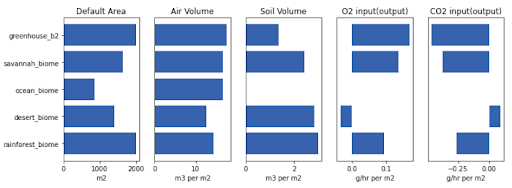by Grant Hawkins, lead developer for SIMOC B2 at Over the Sun, LLC
Storytelling is a core part of SIMOC, especially when it comes to the educational components. As we integrate Biosphere 2 into SIMOC, we’re focused on telling one story in particular: how the soil and concrete conspired to crash O2 levels during Mission 1.
This story was first told in a research paper from January 1994, Oxygen Loss in Biosphere 2. Over the course of Mission 1, the O2 level in the habitat fell quickly, but the CO2 levels didn’t show the expected corresponding rise. The obvious hypothesis is that there was an unaccounted-for O2 consumer. The paper showed that in fact two separate processes were more active than was expected: soil respiration, which consumed O2 and produced CO2, and concrete carbonation, which consumed CO2. The combined effect of both of these was the observed ‘O2 consumer’. We created 5 new agents in SIMOC – 1 concrete and 4 soil-containing biomes – and calibrated them to the measurements in the research paper.
The concrete agent models the process of carbonation. Each step of the simulation, carbonation occurs based on a diffusion rate and a saturation point. The saturation point is heavily dependent on the current CO2 concentration in the atmosphere, however, more than 10x higher under extreme conditions like those at Biosphere 2, which accounted for the unexpected difference in total uptake. We corresponded by email with Bill Dempster, an author of the paper above, about the problem and our approach to it.

The biomes model the combined effect of the soil and ground vegetation in the rainforest, savannah, desert and intensive agriculture biome (farm). A paper from 1999 measured the net productivity of the rainforest and desert biomes, and the Oxygen Loss in Biosphere 2 paper gives the habitat-wide soil respiration.

If all goes according to plan, the net effect of the humans, plants, concrete and biomes will be the drop in O2 observed in real life. This then becomes a story we can tell in SIMOC: the oxygen levels fall much faster than carbon dioxide rises, and the user can discover that it’s being ‘caused’ by the concrete and biomes.

